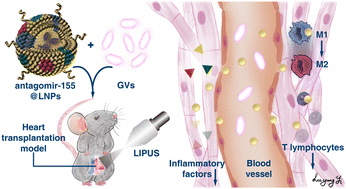Targeted microRNA delivery by lipid nanoparticles and gas vesicle-assisted ultrasound cavitation to treat heart transplant rejection†
Abstract
Despite exquisite immune response modulation, the extensive application of microRNA therapy in treating heart transplant rejection is still impeded by poor stability and low target efficiency. Here we have developed a low-intensity pulsed ultrasound (LIPUS) cavitation-assisted genetic therapy after executing the heart transplantation (LIGHT) strategy, facilitating microRNA delivery to target tissues through the LIPUS cavitation of gas vesicles (GVs), a class of air-filled protein nanostructures. We prepared antagomir-155 encapsulated liposome nanoparticles to enhance the stability. Then the murine heterotopic transplantation model was established, and antagomir-155 was delivered to murine allografted hearts via the cavitation of GVs agitated by LIPUS, which reinforced the target efficiency while guaranteeing safety owing to the specific acoustic property of GVs. This LIGHT strategy significantly depleted miR-155, upregulating the suppressors of cytokine signaling 1 (SOCS1), leading to reparative polarization of macrophages, decrease of T lymphocytes and reduction of inflammatory factors. Thereby, rejection was attenuated and the allografted heart survival was markedly prolonged. The LIGHT strategy achieves targeted delivery of microRNA with minimal invasiveness and great efficiency, paving the way towards novel ultrasound cavitation-assisted strategies of targeted genetic therapy for heart transplantation rejection.

- This article is part of the themed collection: Biomaterials Science Recent HOT Articles


 Please wait while we load your content...
Please wait while we load your content...